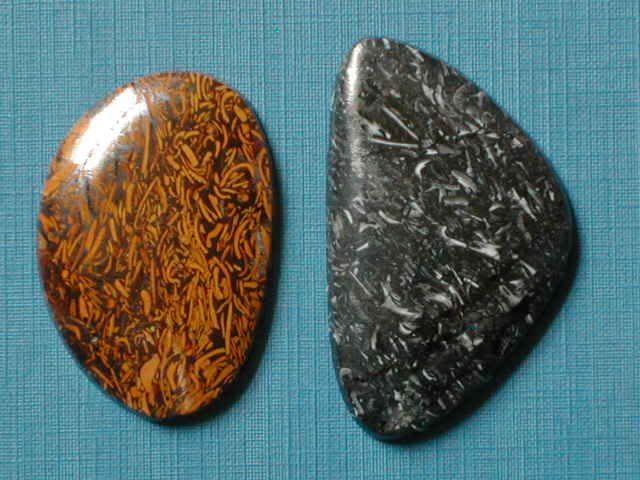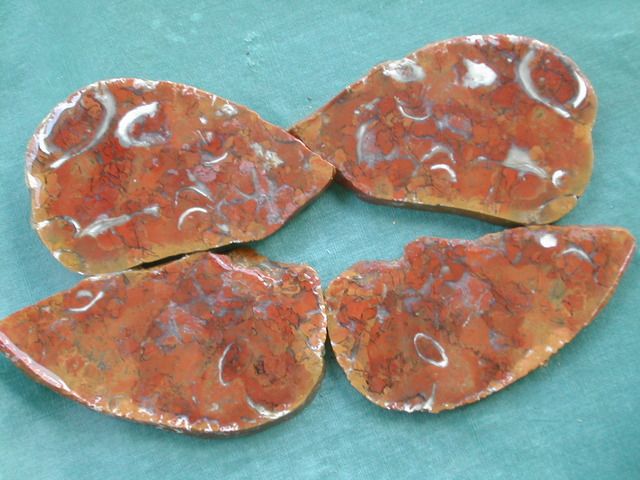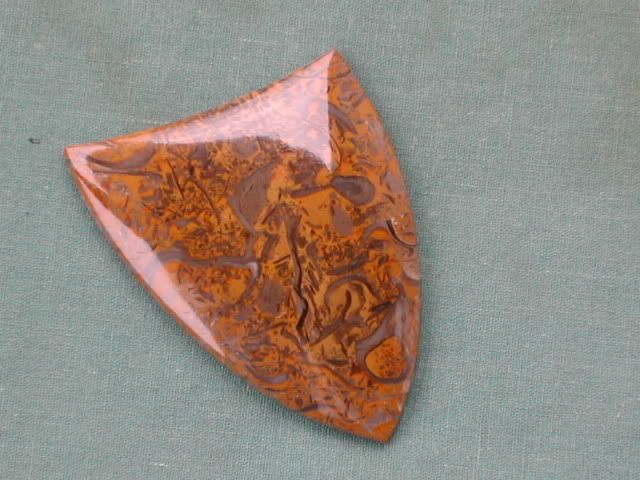|
|
Post by fantastic5 on May 22, 2017 12:26:47 GMT -5
I googled 'cross section of bivalve shell' and found this.  From this drawing I can see how the ladder looking things are actually shells in cross section. Very cool looking material. Not sure about how this plays into all the bits in the slab though... |
|
metalsmith
Cave Dweller 
Member since October 2012
Posts: 1,537
|
Post by metalsmith on May 22, 2017 13:05:04 GMT -5
In the USA you seem to have many of our soft rocks infused with silica rocking the hardness up a step and making the rocks more resilient. @shotgunner Scott... maybe not ' is limestone': was limestone. Muddy limestone, given the depths it is found at the sediment is what is known as pelagic ooze, silica, that's where the replacement minerals originate coming from radiolaria since the terrestrial sediment sources are too distal. The sediments deposit out at the basin margins, but this is deep-sea / ocean material. Given the amount of shelly matter, it couldn't be anything else but a muddy lime originally. It is also worth looking at Belemnites in section - they'd fit the profile too. |
|
Deleted
Deleted Member
Member since January 1970
Posts: 0
|
Post by Deleted on May 22, 2017 13:07:18 GMT -5
I googled 'cross section of bivalve shell' and found this.  From this drawing I can see how the ladder looking things are actually shells in cross section. Very cool looking material. Not sure about how this plays into all the bits in the slab though... Interesting. Thanks Ann!! |
|
|
|
Post by coloradocliff on May 22, 2017 14:45:24 GMT -5
That's a nice one Scott. Glad you had good luck finding some! Technically, since those are tiny clams, Coquina is usually the ID term used but it is also sometimes called Pt. Mugu Shell Rock. Devil's Toenails is more correctly applied to the Texas fossil rock that contains little Oyster fossils by that name. The California stuff is variable in hardness but the better pieces take a pretty good polish. Here's a cab of the CA Coquina vs the similar Indian stuff. No crinoids, rocks wrong age, much younger. That's just the way your saw hit the various clams. There are gastropods present in some too.  Devil's Toenails with the little Grypha type oysters  The piece with the glyph type oysters is like no other. Darn unique and fine looking stone. Your huge base of knowledge helps all of us less experienced but no less enthusiastic people learn. Appreciate your deep words of wisdom. They will be passed on.. Is the indian version more consistently harder? Thanks Mel.
|
|
Sabre52
Cave Dweller  Me and my gal, Rosie
Me and my gal, Rosie
Member since August 2005
Posts: 20,504
|
Post by Sabre52 on May 22, 2017 16:30:34 GMT -5
You know, I'm not certain what the base rock is. I'm thinking a siliceous limestone or siltstone. A knife will scratch my examples but just barely so I'd say hardness in parts of the matrix at least approaches mohs 5 or 6 but seems quite variable. The Indian material varies in hardness too with some harder and some softer than the Pt. Mugu stuff but the Indian material often tends to be very porous while the California material is quite solid. LA Museum of Natural History said the material is clamshell fragments and they do have a crinoid look to them if cut in certain sections but are not crinoids. Some hunks do have Turritella ( true Turritella, not the Wyoming brackish water Goniobasis snail) type marine snails as long as three inches or so and since various gastropods are associated with clams and their shells are scattered in clamshell beds, their fragments may add to the confusion. We have coquina type stuff in Texas too but the clamshell fragments are much larger and the matrix is very hard chert but I think the Texas material is from a much older period than the Miocene California material. The Devil's Toenails is so common in some of the Rio grande gravel beds that I use it sometimes to sharpen my saw blades. The silica rich oyster shell infused limestone comes in all kinds of colors but tan to golden brown to yellow and orange are the most common and pink the most rare. The Texas cherty coquina can be pretty colorful sometimes though the shells are not as numerous. This is the fully silica replaced clamshell stuff found in the Rio Grande gravels.....Mel  Texas limestone Coquina cab. Very polishable limestone  |
|
Deleted
Deleted Member
Member since January 1970
Posts: 0
|
Post by Deleted on May 22, 2017 18:49:17 GMT -5
Thank you Mel!! You are awesome!!
It has a hackly break too. Not conchoidal.
|
|
jeannie
spending too much on rocks
 
Member since January 2017
Posts: 266 
|
Post by jeannie on May 22, 2017 20:16:29 GMT -5
I'm excited to get to work with this stuff!!!
|
|
Deleted
Deleted Member
Member since January 1970
Posts: 0
|
Post by Deleted on May 22, 2017 21:04:40 GMT -5
Mel, is there any chance at all this is pseudofossil? Sabre52 |
|
Sabre52
Cave Dweller  Me and my gal, Rosie
Me and my gal, Rosie
Member since August 2005
Posts: 20,504
|
Post by Sabre52 on May 22, 2017 21:45:23 GMT -5
Nope, real shell fragments in the matrix. If I put some under my dissecting scope, various pieces show definite shell anatomy. You can see pieces of edges, pieces of the valves and in some cases a cross section of the entire shell. Coquina shells are usually of the genus Donax but some of the shells in the shell rock appear to have wavy edges and Donax I've seen is a very smooth shell. Maybe some real fossil expert here who knows Commiefornia fossils well can ID the shells more accurately..Mel
|
|
Deleted
Deleted Member
Member since January 1970
Posts: 0
|
Post by Deleted on May 22, 2017 22:47:04 GMT -5
I will have access to a scope TOMORROW night at class.
Thank you kind sir.
|
|
Deleted
Deleted Member
Member since January 1970
Posts: 0
|
Post by Deleted on May 23, 2017 22:23:56 GMT -5
100% this material is marble. Highly acid reactive.
I'm still saying still harder than steel.
Takes an interesting polish. The shells and other fragments polish better than matrix.
Pix soon
|
|
Deleted
Deleted Member
Member since January 1970
Posts: 0
|
Post by Deleted on May 23, 2017 22:27:54 GMT -5
First one reflecting a flourescent light and the second showing details.   |
|
|
|
Post by coloradocliff on May 23, 2017 22:30:32 GMT -5
Sabre52 Would you help identify these features? Not just the big one, but at least three smaller ladder shaped ones. I can't see how they are bivalves.  Chas this isn't limestone. Steel won't scratch it. metalsmith Shake up, wake up fossilman too, he has been on a roll lately.. |
|
Deleted
Deleted Member
Member since January 1970
Posts: 0
|
Post by Deleted on May 24, 2017 9:43:54 GMT -5
 I'm noticing that the black tube structures polish better than the rest of the fossils. On careful examination I see at least four types of fossils in there. The clams The shiny black tubes Feathery thingies Maggot worm penis shapes Each with its own color. |
|
Sabre52
Cave Dweller  Me and my gal, Rosie
Me and my gal, Rosie
Member since August 2005
Posts: 20,504
|
Post by Sabre52 on May 24, 2017 14:58:58 GMT -5
Scott, probably cuts through the suture where thee valves connect and the shell is thickest. You are seeing both valves ( both sides of the clam. And remember this is a fossil graveyard of stuff that has settled to the bottom. There are scallops cockles etc that could have shell fragments in the mix. There are also snails, gastropods, in this broken shell mix too. Probably shell fragments from lots of ocean organisms besides just clams Some of the ladder looking sections could be cuts through broken gastropod shell sections too. Also many sea worms have calcareous shells too and could be in the mix as could oysters, echinoderms like sand dollars etc. I've omitted crinoids simply because they are more scarce in that time period. Could be some there but much less likely. I've never seen any in the mix....Mel
|
|
Deleted
Deleted Member
Member since January 1970
Posts: 0
|
Post by Deleted on May 24, 2017 15:04:34 GMT -5
Thanks Mel. This is definitely shell soup! I like it a lot. Have to be back for some personal business in weekend after next. jeannie and I will fill my truck. aDave will likely join us. I'll put a piece in the truck for my ailing friend. Don't worry Dave! Sabre52 |
|
Sabre52
Cave Dweller  Me and my gal, Rosie
Me and my gal, Rosie
Member since August 2005
Posts: 20,504
|
Post by Sabre52 on May 24, 2017 15:18:25 GMT -5
Scott: Regarding the crinoid thing. We have a lot of crinoidal limestone ( actually more marble) in Texas near where I live. Unfortunately, most is in parks or on prvt land but I have hunted it on the Lambert ranch and have cut a lot Have never cut crinoidal material without seeing a lot of the prefect circles and disks associated with the stalks and tentacles That to me is always a good identifier....Mel
|
|
|
|
Post by coloradocliff on May 24, 2017 16:45:45 GMT -5
You know, I'm not certain what the base rock is. I'm thinking a siliceous limestone or siltstone. A knife will scratch my examples but just barely so I'd say hardness in parts of the matrix at least approaches mohs 5 or 6 but seems quite variable. The Indian material varies in hardness too with some harder and some softer than the Pt. Mugu stuff but the Indian material often tends to be very porous while the California material is quite solid. LA Museum of Natural History said the material is clamshell fragments and they do have a crinoid look to them if cut in certain sections but are not crinoids. Some hunks do have Turritella ( true Turritella, not the Wyoming brackish water Goniobasis snail) type marine snails as long as three inches or so and since various gastropods are associated with clams and their shells are scattered in clamshell beds, their fragments may add to the confusion. We have coquina type stuff in Texas too but the clamshell fragments are much larger and the matrix is very hard chert but I think the Texas material is from a much older period than the Miocene California material. The Devil's Toenails is so common in some of the Rio grande gravel beds that I use it sometimes to sharpen my saw blades. The silica rich oyster shell infused limestone comes in all kinds of colors but tan to golden brown to yellow and orange are the most common and pink the most rare. The Texas cherty coquina can be pretty colorful sometimes though the shells are not as numerous. This is the fully silica replaced clamshell stuff found in the Rio Grande gravels.....Mel  Texas limestone Coquina cab. Very polishable limestone  Thanks Mel, Read every word... C.
|
|
rebeccaink
starting to spend too much on rocks
 
Member since May 2017
Posts: 190 
|
Post by rebeccaink on May 29, 2017 21:42:48 GMT -5
Sorry to hijack your thread but is this the same thing? Devil's Toenails seems to fit!  If not, sorry, move along lol |
|